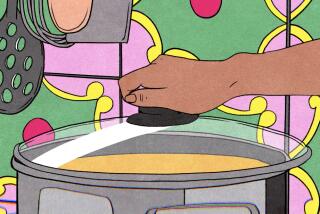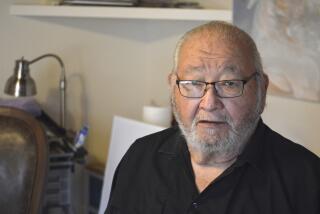To Be or Knot to Be: the Magic of Poetry
- Share via
There are, they say, poets who don’t know it, and there are poets who do. This has to do with both classifications.
As for poets who don’t know it, I shall mention ravens pumping their ebony through the sky, and puppies at play and babies with their first smiles. And dolphins frolicking in cobalt seas around a passing boat. And pole-vaulters and circus aerialists defying gravity for a few seconds. And bricklayers who move with grace and precision at their work on walls. And wood-turners at their lathes. And myself at my preposterous business of performing a certain magic trick.
This is not my opinion about myself. It is the opinion of a poet who knows it. He is John J. Brugaletta. He actually wrote a poem about me doing a certain magic trick. It had to do with magically causing knots to pass from one set of silk handkerchiefs to another. Until Brugaletta, a professor in the English department of Cal State Fullerton, wrote about it, I never thought of it as being a poetic trick.
Brugaletta sent the poem, entitled “The Secret Knots of Morning,” to me along with issue No. 1 of the “SouthCoast Poetry Journal,” which was published by the university’s English department. It is the first nationally circulated publication devoted to contemporary poets from around the nation to be produced in Orange County.
Here is a brief sampling of a few excerpts of what a poetic jury of peers, who served as editors, selected as being the best in the nation submitted to them:
Once I thought myself too young
to die; all of my flapping
like a flag in the wind, now
whole days go by with only
your touch to reaffirm that I
am still alive . . .
This excerpt from “Reaffirmation” is by Susan A. Katz of Monsey, N.Y.
Anybody who has been seriously ill in a hospital knows that feeling of intense mortality. That’s one of the purposes of poetry: to concentrate and synthesize the human experience, the important and the unimportant.
In his “Winter Solstice,” Donald A. Sears of Laguna Beach, the only Orange County poet represented in the new magazine, ponders on the “indrawn solitude” that affects us on a rainy day.
The same rains falling
Hiss on broken leaves
Which silently
The sea receives
Waiting, as I wait--
Here, until I leave.
Walter Griffin of East Point, Ga., in his “Bicycle in the Rain,” dreams of “water diamonds” glistening “on the red fenders where I left them thirty years ago.”
. . . while the middle age man
in me
slams on brakes that do not exist.
The falling is real. The fenders
shine
on bicycle dreams that peddle in
air.
John Hollander of Woodbridge, Conn., contemplates a commonplace article in his four-line submission (complete here), with a title nearly as long as his verse--”On a Tag Tied To a Winesap.”
O apple, with which--as first fruit of desire--
Our hunger for significance is fed;
Around your globe pale grass border on fire,
The lovesick green pursues the blushing red.
The editor himself, Brugaletta, appropriately pens a poetical preface to this first journal, which will be published twice yearly, in May and December. He writes of “Gray Whales.”
Descending in ponderous families down
the western coast of America the grays
follow the crumble of land like ancient sailors
afraid of the open sea . . .
Now, having mentioned again the good poet professor, here is an excerpt from the true magic of my knot trick (his writing of it) which he saw performed at a meeting in Corona del Mar’s Sherman Garden.
He carried with his thumb
and index finger every knot--a space,
while every leaf and blossom grew a face
alert with worry that this cheerful chum
might carry in his fingers special grace:
The great creation’s raveling to come.
Doesn’t that send shivers down your spine? . . . Well it did mine.
More to Read
Sign up for our Book Club newsletter
Get the latest news, events and more from the Los Angeles Times Book Club, and help us get L.A. reading and talking.
You may occasionally receive promotional content from the Los Angeles Times.






